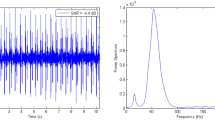Abstract
The fetal phonocardiogram, which is the acoustic recording of mechanical activity of the fetal heart, facilitates the measurement of the instantaneous fetal heart rate, beat-to-beat differences and duration of systolic and diastolic phases. These measures are sensitive indicators of cardiac function, reflecting fetal well-being. This paper provides an algorithm to non-invasively estimate the phonocardiogram of an individual fetus in a multiple fetus pregnancy. A mixture of fetal phonocardiograms is modeled by a generalized pure delayed mixing model. Mutual independence of fetal phonocardiograms is assumed to apply blind source separation based techniques to extract the fetal phonocardiograms from their mixtures. The performance of the algorithm is verified through simulation results and on experimental data obtained from a phantom that is used to simulate a twin pregnancy.














Similar content being viewed by others
References
Martin, J., Births: final data for 2000. Natl. Vital Stat. Rep. 50(5), 2002.
Lathauwer, L., Moor, B., and Vandewalle, J., Fetal electrocardiogram extraction by blind source subspace separation. IEEE Trans. Biomed. Eng 47:5567–572, 2000.
Liang, H., Lukkarinen, S., and Hartimo, I., Heart sound segmentation algorithm based on heart sound envelogram. Comput. Cardiol., pp. 105–108, 1997.
Greenfield, M., Hearing the fetal heartbeat. Dr. Spock Website, available at: http://www.drspock.com/article/0,1510,9851,00.html (last accessed Feb. 2006), 2001.
McDonnell, E., and Dripps, J. H., Processing and analysis of fetal phonocardiograms. Proc. Annu. Int. Conf. IEEE Eng 1:61–62, 1989.
Ibrahimy, M. I., Ahmed, F., Ali, M. A. M., and Zahedi, E., Real-time signal processing for fetal heart rate monitoring. IEEE Trans. Biomed. Eng 50:2258–261, 2003.
Burel, G., Blind separation of sources: a nonlinear neural algorithm. Neural Netw 5:6937–947, 1992.
Jutten, C., and Herault, J., Blind separation of sources, part 1: an adaptive algorithm based on neuromimetic architecture. Signal Process 24:11–10, 1991.
Platt, J. C., and Faggin, F., Networks for separation of sources that are superimposed and delayed. In: Moody, J., Hanson, S., and Lippman, R. (Eds.), Advances in Neural Information Processing Systems 4Palo Alto: Morgan-Kaufmann, 730–737, 1992.
Delfosse, N., and Loubaton, P., Adaptive separation of independent sources: a deflation approach. In: Proc. ICASSP, pp. 41–44, Adelaide, Australia, 1994.
Karhunen, J., Wang, L., and Vigario, R., Nonlinear PCA type approaches for source separation and independent component analysis. In: Proc. ICNN, Perth, Western Australia, 1995.
Cardoso, J. F., Belouchrani, A., and Laheld, B., A new composite criterion for adaptive and iterative blind source separation. In: Proc. ICASSP, pp. 273–276, Adelaide, Australia, 1994.
Comon, P., Independent component analysis, a new concept? Signal Process 36:3287–314, 1994.
Kam, A., and Cohen, A., Separation of twins fetal ECG by means of blind source separation. Electrical and electronic engineers in Israel. The 21st IEEE Convention, pp. 342–345, 2000.
Torkkola, K., Blind separation of delayed sources based on information maximization. In: Proc. IEEE ICASSP, pp. 3509–3513, 1996.
Kovacs, F., Torok, M., and Habermajer, I., A rule-based phonocardiographic method for long-term fetal heart rate monitoring. IEEE Trans. Biomed. Eng 47:1124–130, 2000.
Bell, A., and Sejnowski, T., An information maximization approach to blind separation and blind deconvolution. Neural Comput 7:61004–1034, 1995.
Nigam, V., and Priemer, R., Blind separation of mixtures of delayed sources. In: Electronic Proceedings of CITSA, Orlando, FL, 2004.
Emile, B., Comon, P., and Leroux, J., Estimation of time delays with fewer sensors than sources. IEEE Trans. Signal Process 46:72012–2015, 1998.
eGeneralMedical.com, Product information cardiac auscultation of heart murmurs. Available at: http://egeneralmedical.com/listohearmur.html (last accessed Feb. 2006)
Amari, S., Cichocki, A., and Yang, H. H., A new learning algorithm for blind signal separation. Advances in neural information processing systems. Vol. 8. Cambridge, MA: MIT, 752–763, 1996.
Messer, S., and Abbott, D., Optimal wavelet denoising for phonocardiograms. Microelectron. J 32:12931–941, 2001.
Donoho, D. L., De-noising by soft thresholding. IEEE Trans. Inf. Theory 41:3613–627, 1995.
Nigam, V., and Priemer, R., A snore extraction method from mixed sound for a mobile snore recorder. J. Med. Syst. 30:91–99.
Acknowledgements
Vivek Nigam is supported by a fellowship from the Prakash Agarwal Foundation. We thank Todd Spohnholtz and his advisor Dr. T. J. Royston of the Acoustics and Vibrations Laboratory, Univ. of Illinois at Chicago, for providing the Inexpensive Piezoelectric Acoustic Sensors (IPAS) to record FPCGs in “Experiments and results.”
Author information
Authors and Affiliations
Corresponding author
Rights and permissions
About this article
Cite this article
Nigam, V., Priemer, R. Generalized Blind Delayed Source Separation Model for Online Non-invasive Twin-fetal Sound Separation: A Phantom Study. J Med Syst 32, 123–135 (2008). https://doi.org/10.1007/s10916-007-9115-7
Received:
Accepted:
Published:
Issue Date:
DOI: https://doi.org/10.1007/s10916-007-9115-7




